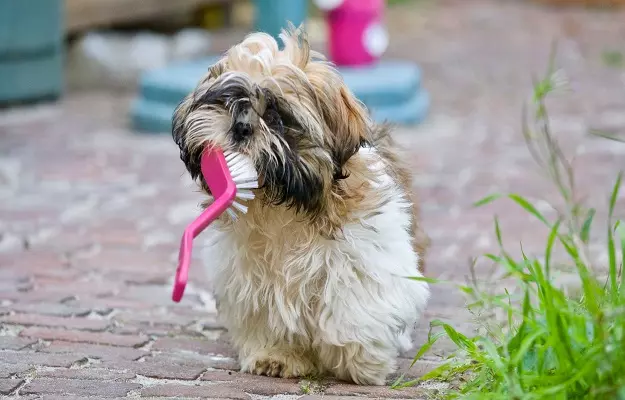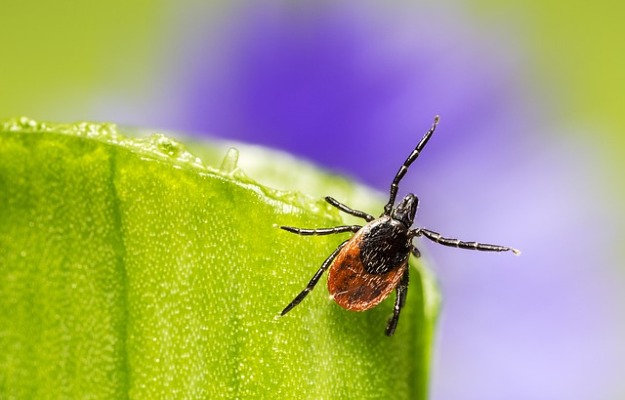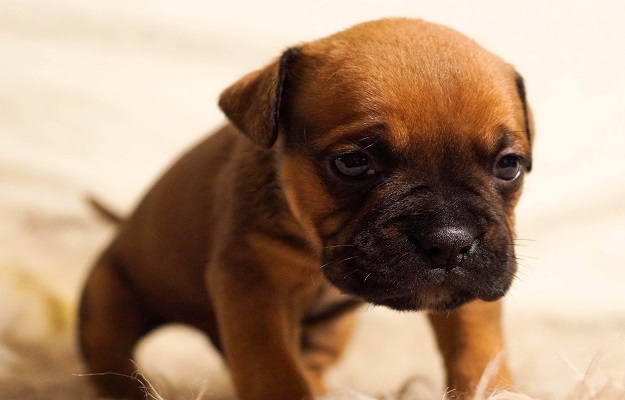Bathing, cleaning and grooming your dog is very important, and not just for the sake of appearances. Every dog owner should understand that grooming your dog is necessary to maintain hygiene and physical health.
What poses a challenge for most dog owners is teaching their beloved pup to endure the grooming process. You could definitely send your dog to a pet parlour, where trained experts will clean up your dog and send him or her home with a shiny coat of fur, clean ears and bright eyes.
But pet parlours and professional dog groomers can be quite expensive, and not every pet owner can afford them. This is the reason why all dog owners should know grooming basics so that you can take care of your best friend’s health.
While what is required and how often might differ from breed to breed, there are a number of vital areas that need to be attended to, no matter your dog’s breed, size, gender or age. Of course, training your dog to endure grooming should be started while he or she is still a puppy, but even if you start late, the following tips will help you out.
(Also read: Fracture in dogs: Signs, causes, types, diagnosis)
- Grooming do’s and don’ts for your dog
- Bathing your dog
- Brushing your dog’s hair
- Cleaning your dog’s eyes
- Cleaning your dog’s ears
- Clipping your dog’s nails
- Cleaning your dog’s teeth
- Cleaning your dog’s genitals and anus
- Takeaway
Grooming do’s and don’ts for your dog
It’s important to remember that you are your dog’s primary care provider. This means that you not only have to make sure that your dog is clean and healthy, but also that any choices you make regarding his or her care - from choosing the right shampoo to getting the proper nail clippers - is your responsibility. Here are a few do’s and don’ts you should keep in mind.
(Also read: What to do if your dog has fleas)
Dog grooming do’s
Be regular: You can’t start grooming your dog once and go without it for months after that. Dogs need to be groomed at least once every week, and some practices should be followed every day. Brushing your dog’s coat can be done every alternative day, but cleaning the eyes and genitals should be a daily routine after walks. Plus, if you groom your dog regularly, your dog will become more patient during these sessions.
Be patient: Yes, your dog might not want to settle down during a bath, and clipping a dog’s nails can be frustrating too. But remember that dogs can always sense your emotions. If you are frustrated, impatient or angry during the grooming session, your dog will also get fidgety.
Choose the right spot: Not all dogs can be bathed within the confines of a bathroom. Large dogs inevitably need more space, especially if they don’t like bathing. This is why you should choose the right place to bathe, clean and groom your dog. This space should be safe for both you and your dog, so that both of you can relax and get the grooming done without getting stressed.
Choose the right equipment: The type of brush, nail clippers, scissors, trimmers, etc you need to groom your dog should be appropriate for his or her fur type and length, gender and breed. You will also need tweezers and medications during tick season. The following are things you should have at hand if you own a dog:
- Gloves
- Brush for fur
- Brush for teeth
- Toothpaste
- De-shedding comb
- Trimming scissors
- Nail clippers
- Shampoo and conditioner
- Towels
- A tub
- Bath sponge or soft brush
- Hose pipe with a spray head
- Tick and flea medication
- Antiseptic cream or gel
Know your dog: Every breed of dog, even Indies, has specific necessities which you should be able to meet. Get all the medical history you might need right at the time of adoption, and then get informed about the essentials you cannot do without. For example, if you have a Rottweiler or Dobermann, chances are that you will need to exercise them more, and therefore clean them thoroughly and more often. Pugs have sensitive eyes, so cleaning them properly will need more care. Being knowledgeable about these factors will only help you.
Know your limits: You might have the right intentions, but you cannot possibly do everything your dog needs. If you are not trained or if a veterinarian doesn’t show you the right way, things like emptying your dog’s anal glands or sacs can be daunting. There are certain things that a professional needs to do for your dog, and accepting this will help you keep your dog safe and healthy.
(Also read: Kennel cough in dogs)
Dog grooming don’ts
Don’t hurry: Rushing through the grooming process has obvious pitfalls. Your dog will not be able to establish it as a routine, and the clean-up will not be thorough. You might even accidentally end up hurting your dog. Be patient, take it slow, and make it enjoyable if possible. This will even make your dog look forward to grooming and bathing sessions.
Don’t bathe your dog too often: Dogs should be bathed only when needed, i.e. when they are dirty, smelly or have an infection or infestation that requires it. This is because dogs’ have natural oils in their skin, and over-washing can strip them of these and lead to skin diseases.
Don’t neglect any part of the body: Simply because cleaning the genitals and anus seems complicated or disgusting does not mean that you shouldn’t do it. Cleaning every body part of your dog is essential, and you should not skip over or rush through cleaning any bit.
Don’t get unnecessary things: While getting the right equipment is necessary, don’t get carried away and buy dog grooming products which your dog doesn’t need. Perfumed shampoos may look great, but they can also irritate your dog’s skin and nose.
Don’t give up: Grooming your dog regularly can be overwhelming and it will definitely take some time out of your daily schedule to do it properly and with patience. While it may seem very difficult, it’s important not to give up on grooming your dog.
(Also read: Canine distemper)
Bathing your dog
Giving your dog a bath can be a fun experience, especially if he or she really enjoys it. Bathing during summers is more enjoyable for most dogs living in warm climates. If you’re bathing your dog in the winter then do bathe your dog indoors so that the low temperature doesn’t affect your dog’s health. Here are a few tricks you can use while bathing your dog:
- The frequency of dog baths depends on the particular needs of individual dogs. Usually, dogs should be bathed only if they get dirty or if they smell bad. If you bathe them too much, or when they smell normal (remember that dogs have their own healthy smell), it can dry out their skin and lead to skin diseases.
- It’s also very important to get the right shampoo for your dog. Human and dog skins have very different pH values, so you should not use the same product you use for your dog. Get a shampoo meant for dogs to ensure their safety and health.
- While choosing the bath spot should be about your convenience - not every dog owner has a huge garden or porch to bathe their dog outdoors - you should also take your dog’s comfort into account. Get the right sized tub for them and make the bathing spot comfortable with toys and reward treats.
- Use the praise and reward system to train your dog to be comfortable during bath times, and don’t be too harsh during these times. This will help your dog associate bathing with positive things, and help condition him or her into enjoying, even looking forward to, baths.
- Familiarise your dog with bathing equipment. You can even make your dog practise sitting in the tub and a mat or towel so that they imbibe these behaviours. Familiarising them with running water will also help.
- Exercise your dog before bath time. This way he or she will have spent a lot of energy outdoors and will remain calm during baths.
Use the following steps while bathing your dog to ensure he or she is clean and comfortable:
- Brush your dog to ensure there are no mats or tangles in the fur.
- Wet your dog thoroughly to the skin using a hose, but don’t wet the head area.
- Clean the dog’s face and head with a damp washcloth. You can use damp cotton balls to clean the eyes.
- Keep the dog’s ears dry. If you get them wet it can cause infections.
- Once your dog’s body is thoroughly wet, add the shampoo. Start with the chest area and gradually rub it down the entire body.
- Massage the shampoo and lather on the shoulders, sides, back, front legs, back legs and tail. Massage the underside last, after the dog is comfortable enough.
- Rinse the shampoo gently yet thoroughly with water.
- If you’re using a conditioner, apply it and leave it on for 2-3 minutes. Rinse it off with water thoroughly.
- Towel dry your dog, even if they shake off water right after the bath. Allow the dog to dry off naturally. Do not use dryers unless absolutely necessary.
- Gently brush your dog after he or she is completely dry.
(Also read: Why is my dog tired all the time: Lethargy in dogs)
Brushing your dog’s hair
You need to brush your dog’s coat several times a week to ensure that the fur is untangled, clean and shiny. Regular brushing also ensures that your dog doesn’t shed too much hair. Dogs with shorter fur will need less intensive brushing than those with long fur, and you should buy a brush suitable to your dog’s fur. If your dog’s hair is medium or long you will need a bristled brush, and you can even get a slicker brush if the fur gets tangled or has mats.
Remember to brush all the way down to the skin to ensure dandruff and dirt comes off properly. You should be on the lookout for cuts, scrapes, and mats behind the ears and under the legs. If the mats, cuts and scrapes are too severe, you should treat them or take your dog to the vet immediately.
(Also read: Diabetes in dogs)
Cleaning your dog’s eyes
A dog’s eyes are expressive, soulful and commanding, but they are also extremely sensitive. Most dogs are curious and tend to burrow into dirt, which leaves their face - and especially eyes - exposed to germs of all kinds. This is why it’s important to monitor your dog’s eye health and clean your dog’s eyes properly.
You don’t need any equipment to clean your dog’s eyes. Moist cotton balls are all you need, but use water and avoid irritating substances. Gently clean around the eyes, remove any globs by wiping gently. Hold your dog’s head firmly while doing so, but make sure you don’t hurt the snout, nose or eyes at this point. A healthy dog’s eyes are usually clear and bright, so if you see any redness, discharge or bumps (which are symptomatic of eye problems like cherry eye in dogs), you should consult the vet immediately.
Cleaning your dog’s ears
Your dog’s ears are very sensitive, and cleaning them should be done very carefully. You should clean your dog’s ears once a month, but in case your dog has ear problems and if the vet recommends it, you can clean the ears more frequently.
Use a damp cloth or cotton swab to clean the outer part of the ear. You can soak the cotton swab in mineral oil if needed, but do consult your vet before using any cleaning agent. You should also consult your vet if your dog shows the following symptoms:
- Head shaking
- Ear discharge
- Ear scratching
- Rubbing ears on floor, furniture, clothes, etc
- Redness or swelling around the ear
- Sensitivity around the ear or head
- Ear bleeding
- Head tilt
- Unpleasant odour
(Also read: Ear mites in dogs)
Clipping your dog’s nails
A dog’s nails should be kept short for the feet to remain healthy, because long nails affect the dog’s gait and makes walking awkward and painful. Long nails can also lead to injuries and scratches. This is why clipping a dog’s nails is very important, and you should use specially-designed nail clippers for dogs to do this.
If you hear your dog’s nails clicking on the floor, then it’s time to clip them. The base of dogs’ nails have nerves and a blood vessel called quick, so you need to be very careful while clipping the nails. It’s best to ask your vet to show you how to do it properly the first few times, so that you can avoid accidental bleeding or injuries. Clipping the hooked part of the nail is a safe way to do it.
Dogs usually do not like getting their nails clipped, so make sure your dog is securely held and soothed while doing so. A file can be used to smoothen the rough edges of the cut nail. If you accidentally cut the quick, then stop the bleeding with styptic powder or any other medication recommended by your vet. If you’re unsure about this, go to a vet or groomer to ensure your dog’s safety.
(Also read: Why is my dog not eating: Inappetance in dogs)
Cleaning your dog’s teeth
To maintain your dog’s dental health, it’s very important to give them safe and clean chew toys. Chewing is a natural behaviour, and it promotes teeth and gum health. Apart from this, it’s very important to clean your dog’s teeth frequently. Specially-designed toothbrushes and toothpastes are available for dogs, and it’s better to use them instead of products made for humans.
Put some toothpaste on a wet brush and gently brush your dog’s teeth. If your dog doesn’t like brushing with a toothbrush then use your fingers to clean and massage the dog’s teeth and gums. Make sure that you familiarise your dog to the toothpaste beforehand. Accumulation of tartar in the teeth is normal with aged dogs, and can only be treated by a vet.
(Also read: Dental disease in dogs)
Cleaning your dog’s genitals and anus
Cleaning your dog’s genitals and anus is a very important part of their grooming, and should not be skipped. This can be done whenever your dog has a bath. Make sure you are gentle while cleaning the genitals, and wipe from front to back to avoid the spread of bacteria.
Since dogs sit on the floor or the ground during their walks, their genitals and anus come into contact with many surfaces. This is why you should wipe your dog’s genitals and backside with a damp cloth whenever he or she comes back from a walk. If you see any signs of infection, redness or discharge then you should contact the vet immediately.
A dog’s anal sacs are located on the sides of the anus, and they should be emptied from time to time to avoid infections and foul odours. This, however, is best done by a veterinarian. So do remember to ask your vet to do so during your visits. If you see your dog licking, scratching or rubbing his or her anus you should take your dog to the vet immediately because these are signs of impacted anal sacs.
(Also read: Diarrhea in dogs)
Takeaway
Maintaining your dog’s hygiene is very important for his or her health. Bathing, brushing the coat, clipping the nails, cleaning the eyes, ears, teeth, genitals and anus - these all should be done regularly. While you can take your dog to the local pet parlour to get groomed, it’s always best to know the grooming basics because not everyone can afford a professional groomer, and some things - like brushing the coat, cleaning the eyes, teeth and genitals - need to be done frequently to ensure your dog’s health. The above mentioned tips should help you bathe and groom your pet. It’s important to get the right equipment for grooming, and you should be especially careful while clipping your dog’s nails and ears. Following these guidelines properly should keep your dog happy, healthy and active, but if you see any severe infestations of ticks and fleas, or if there’s discharge, mucus, rashes, etc then you should take your dog to the vet immediately.
References
- People for the Ethical Treatment of Animals [Internet]. Norfolk. Virginia. USA; The Most Important Do’s and Don’ts When Grooming Your Dog at Home
- American Kennel Club [Internet]. New York. USA; How to Groom a Dog
- American Kennel Club [Internet]. New York. USA; The Dos and Don’ts of Home Dog Grooming and Hygiene
- Compend Contin Educ Vet. 2011 Jan;33(1):E1. PMID: 23710522
- AC, Maria. et al. Necropsy findings in dogs that died during grooming or other pet service procedures. J Forensic Sci. 2013 Sep;58(5):1189-92. PMID: 23879553
- Scheifele, Peter M. et al. Noise impacts from professional dog grooming forced-air dryers. Noise Health. 2012 Sep-Oct; 14(60): 224–226. PMID: 23117536
- Wells, DL. Domestic dogs and human health: an overview.. Br J Health Psychol. 2007 Feb;12(Pt 1):145-56. PMID: 17288671














